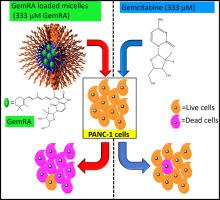Biomaterials Advances ( IF 5.5 ) Pub Date : 2020-07-04 , DOI: 10.1016/j.msec.2020.111251 Hamilton Kakwere 1 , Elizabeth S Ingham 2 , Spencer K Tumbale 1 , Katherine W Ferrara 1

|
The treatment of pancreatic cancer with gemcitabine is hampered by its rapid metabolism in vivo, the dense stroma around the tumor site which prevents the drug from reaching the cancerous cells and drug resistance. To address these challenges, this study describes the preparation of a retinoid prodrug of gemcitabine, GemRA (gemcitabine conjugated to retinoic acid), and its formulation into a nanoparticulate system applicable for pancreatic cancer treatment. Retinoic acid targets stellate cells which are part of the stroma and can thus augment the delivery of gemcitabine. GemRA dissolved in dimethylsulfoxide presented efficacy towards PANC-1 (human) and mT4 (mouse) pancreatic cancer cell lines but its poor solubility in aqueous solution affects its applicability. Thus, the preparation of the nanoparticles was initially attempted through self-assembly of GemRA, which resulted in the formation of unstable aggregates that precipitated during preparation. As a result, encapsulation of the drug into micelles of polyethylene glycol-retinoic acid (PGRA) amphiphilic conjugates was accomplished and resulted in successful incorporation of GemRA into nanoparticles of ca. 33 nm by dynamic light scattering and 25 nm by transmission electron microscopy. The nanoparticles had good stability in aqueous media and protected gemcitabine from the enzymatic action of cytidine deaminase, which converts gemcitabine to its inactive metabolite upon circulation. Cellular uptake of the nanoparticles by PANC-1 cells was confirmed by fluorescence spectroscopy and flow cytometry. Treatment of PANC-1 cells in vitro with the prodrug-loaded nanoparticles resulted in a significant reduction in cell viability (IC50 ca. 5 μM) compared to treatment with gemcitabine (IC50 > 1000 μM). The ability of the GemRA-loaded nanoparticles to induce cellular apoptosis of treated PANC-1 cells was ascertained via a TUNEL assay suggesting these nanoparticles are effective in pancreatic cancer treatment.
中文翻译:

装载吉西他滨-类视黄醇前药的纳米颗粒对具有药物抵抗力的人 PANC-1 胰腺癌细胞表现出体外抗肿瘤功效。
吉西他滨治疗胰腺癌受到其体内快速代谢、肿瘤部位周围致密基质阻碍药物到达癌细胞和耐药性的阻碍。为了应对这些挑战,本研究描述了吉西他滨类视黄醇前药 GemRA(吉西他滨与视黄酸缀合)的制备,及其配制为适用于胰腺癌治疗的纳米颗粒系统。视黄酸靶向星状细胞,星状细胞是基质的一部分,因此可以增强吉西他滨的递送。溶解在二甲亚砜中的 GemRA 对 PANC-1(人)和 mT4(小鼠)胰腺癌细胞系具有功效,但其在水溶液中的溶解度较差,影响了其适用性。因此,最初尝试通过 GemRA 自组装来制备纳米颗粒,这导致了在制备过程中沉淀的不稳定聚集体的形成。结果,完成了将药物封装到聚乙二醇-视黄酸 (PGRA) 两亲性缀合物的胶束中,并成功地将 GemRA 掺入约 100 纳米粒子中。动态光散射为 33 nm,透射电子显微镜为 25 nm。纳米颗粒在水介质中具有良好的稳定性,并保护吉西他滨免受胞苷脱氨酶的酶促作用,胞苷脱氨酶在循环时将吉西他滨转化为其无活性的代谢物。通过荧光光谱和流式细胞术证实了PANC-1细胞对纳米粒子的细胞摄取。在体外用负载前药的纳米颗粒处理 PANC-1 细胞导致细胞活力显着降低(IC 50约 100%)。 5 μM)与吉西他滨治疗(IC 50 > 1000 μM)相比。通过 TUNEL 测定确定了装载 GemRA 的纳米颗粒诱导经处理的 PANC-1 细胞凋亡的能力,表明这些纳米颗粒在胰腺癌治疗中有效。











































 京公网安备 11010802027423号
京公网安备 11010802027423号